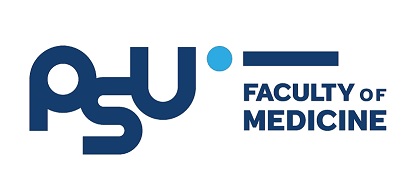ข้อมูลสำหรับผู้แต่ง
ข้อแนะนำสำหรับผู้นิพนธ์บทความเพื่อลงตีพิมพ์เวชสารสงขลานครินทร์ (PSU Medical Journal)
เวชสารสงขลานครินทร์ เป็นวารสารวิชาการทางวิทยาศาสตร์สุขภาพ จัดทำโดยคณะแพทยศาสตร์ มหาวิทยาลัยสงขลานครินทร์ มีวัตถุประสงค์เพื่อเผยแพร่ผลงานวิจัย บทความทางวิชาการและรายงานผู้ป่วยที่น่าสนใจ แสดงถึงวิทยาการและความรู้ใหม่ ซึ่งก่อให้เกิดประโยชน์ทางการแพทย์ วงการสาธารณสุขและผู้สนใจทั่วไป
ภาษาของบทความต้นฉบับ
ผู้นิพนธ์สามารถส่งบทความภาษาไทยหรือภาษาอังกฤษเพื่อลงตีพิมพ์ในเวชสารสงขลานครินทร์ บทความภาษาอังกฤษควรได้รับการแก้ไขภาษาโดยชาวต่างชาติที่ใช้ภาษาอังกฤษเป็นภาษาหลัก ในกรณีที่ประเทศของผู้นิพนธ์ไม่ได้ใช้ภาษาอังกฤษเป็นภาษาราชการให้แนบเอกสารรับรองการแก้ไขภาษามาพร้อมบทความ หากมีข้อสงสัยสามารถติดต่อกองบรรณาธิการได้ทาง skamolth@medicine.psu.ac.th
ค่าตีพิมพ์บทความ
ไม่มีค่าธรรมเนียมในการตีพิมพ์บทความ
การรับรองทางจริยธรรมการวิจัยในมนุษย์
ในกรณีบทความประเภทนิพนธ์ต้นฉบับและรายงานผู้ป่วย ผู้นิพนธ์ต้องแนบหนังสือรับรองที่ได้รับอนุญาตจากคณะกรรมการพิจารณาจริยธรรมการวิจัยในมนุษย์ (Ethic committee) มาพร้อมต้นฉบับด้วย
กิตติกรรมประกาศ
บุคคลผู้มีส่วนช่วยในการทำวิจัยหรือนิพนธ์บทความแต่ไม่ได้อยู่ในรายชื่อผู้นิพนธ์ควรได้รับการกล่าวถึงในกิตติกรรมประกาศ โดยระบุไว้ต่อท้ายบทความหลัก ก่อนคำอธิบายแหล่งเงินทุนวิจัย
แหล่งเงินทุนวิจัย
ในกรณีที่ได้รับทุนวิจัย ผู้นิพนธ์ต้องระบุแหล่งเงินทุนวิจัยไว้อย่างชัดเจน โดยระบุชื่อและบทบาทของแหล่งทุนที่ให้เงินสนับสนุนการทำวิจัย ให้ระบุไว้ก่อนคำอธิบายผลประโยชน์ทับซ้อน
ผลประโยชน์ทับซ้อน
ผู้นิพนธ์ต้องแสดงตนว่ามีผลประโยชน์ทับซ้อนในบทความที่จะลงตีพิมพ์หรือไม่ เช่น การมีความสัมพันธ์ทางใดทางหนึ่งกับบริษัทยา เป็นต้น โดยระบุต่อท้ายกิตติกรรมประกาศก่อนเอกสารอ้างอิง
ขั้นตอนการพิจารณาบทความเพื่อลงตีพิมพ์
- เมื่อได้รับต้นฉบับบทความแล้ว หัวหน้ากองบรรณาธิการและผู้จัดการวารสารจะเป็นผู้พิจารณาเบื้องต้น บทความจะได้รับการตรวจสอบด้วยโปรแกรม ‘Turnitin’ ในกรณีที่ต้นฉบับไม่สมบูรณ์หรือไม่ถูกต้อง จะถูกส่งคืนเจ้าของบทความเพื่อแก้ไขก่อนส่งเข้าสู่กระบวนการทบทวนบทความ (review) ต่อไป
- เวชสารสงขลานครินทร์จะดำเนินการสรรหาและแต่งตั้งผู้ทรงคุณวุฒิจำนวนอย่างน้อย 3 ท่าน ต่อ 1 บทความ บทความที่จะได้รับการตีพิมพ์จะต้องได้รับการยอมรับ (accepted) จากผู้ทรงคุณวุฒิอย่างน้อย 2 ใน 3
- เวชสารสงขลานครินทร์จะพิจารณาผู้ทรงคุณวุฒิที่มีความเชี่ยวชาญในสาขาวิชาเดียวกับบทความ ถึงแม้ผู้นิพนธ์สามารถเสนอรายชื่อผู้ทรงคุณวุฒิเพื่อทบทวนต้นฉบับได้ 5 ท่าน แต่บรรณาธิการจะเลือกเฉพาะผู้ทรงคุณวุฒิที่มีความเชี่ยวชาญในสาขานั้นจริงๆ โดยไม่ขัดต่อหลักเกณฑ์อื่นๆ และทั้งนี้บรรณาธิการอาจไม่เลือกผู้ทรงคุณวุฒิตามที่ผู้นิพนธ์เสนอมาทั้ง 5 คนเลยก็ได้
- กองบรรณาธิการจะสรุปความเห็นของผู้ทรงคุณวุฒิทั้ง 3 ท่านและความเห็นของบรรณาธิการส่งให้ผู้นิพนธ์แก้ไขปรับปรุง
ประเภทของบทความ
- บทบรรณาธิการ (Editorial) ซึ่งได้รับการเชิญจากหัวหน้ากองบรรณาธิการ โดยเรียงลำดับดังนี้ บทนำ (Introduction), เนื้อเรื่อง, สรุป (Conclusion) และเอกสารอ้างอิง (References) โดยเขียนบทความเป็นภาษาอังกฤษหรือภาษาไทย ความยาวของเนื้อหาตั้งแต่บทนำจนถึงสรุปไม่ต่ำกว่า 1,000 คำ และไม่เกิน 1,500 คำ
- นิพนธ์ต้นฉบับ (Original article) และการทบทวนวรรณกรรมอย่างเป็นระบบ (systematic review) หรือการวิเคราะห์อภิมาน (meta-analysis)
2.1 นิพนธ์ต้นฉบับ ให้ลำดับเนื้อหาดังนี้; บทคัดย่อ (Abstract), บทนำ (Introduction), วัสดุและวิธีการ (Material and Method), ผลการศึกษา (Results), บทวิจารณ์ (Discussion), สรุป (Conclusion), เอกสารอ้างอิง (References), กิตติกรรมประกาศ (Acknowledgement), แหล่งเงินทุนวิจัย (Funding resources) และผลประโยชน์ทับซ้อน (Conflicts of interests) ความยาวของบทคัดย่อไม่เกิน 250 คำ ความยาวของบทความ (ตั้งแต่บทนำจนถึงสรุป) ไม่เกิน 3,500 คำ เอกสารอ้างอิงไม่เกิน 40 เรื่อง รูปภาพและตารางรวมกันไม่เกิน 8 รูป
2.2 การทบทวนวรรณกรรมอย่างเป็นระบบ (systematic review) หรือการวิเคราะห์อภิมาน (meta-analysis) ให้มีขอบข่ายรูปแบบการเขียนคล้ายกับบทความนิพนธ์ต้นฉบับ โดยมีความยาวของบทคัดย่อไม่เกิน 250 คำ ความยาวของบทความไม่เกิน 6,000 คำ รูปภาพและตารางรวมกันไม่เกิน 8 รูป แต่ไม่จำกัดจำนวนเอกสารอ้างอิง
- รายงานผู้ป่วย (Case report) ไม่จำเป็นต้องมีหัวข้อย่อย ความยาวของบทคัดย่อไม่เกิน 250 คำ ความยาวของบทความไม่เกิน 2,000 คำ เอกสารอ้างอิงไม่เกิน 15 เรื่อง รูปภาพและตารางรวมกันไม่เกิน 2 รูป
- บทความปริทรรศน์ (Review article) ในหัวข้อที่เกี่ยวข้องกับการแพทย์ แพทยศาตร์ศึกษาและนวัตกรรมด้านการแพทย์และสาธารสุข ให้มีขอบข่ายรูปแบบการเขียนคล้ายกับบทความนิพนธ์ต้นฉบับ โดยมีความยาวของบทคัดย่อไม่เกิน 250 คำ ความยาวของบทความไม่เกิน 6,000 คำ รูปภาพและตารางรวมกันไม่เกิน 8 รูป แต่ไม่จำกัดจำนวนเอกสารอ้างอิง
การเตรียมบทความ
- เตรียมต้นฉบับบทความด้วยโปรแกรมประมวลผล Microsoft Word และบันทึกเป็นนามสกุลไฟล์ .doc ในกรณีทีมีส่วนประกอบอื่นๆ ได้แก่ รูปภาพ, ตาราง, และอื่นๆ ให้บันทึกเป็นนามสกุลไฟล์ .jpg, .jpeg, .tif
- ใบปะหน้า (cover letter) ประกอบด้วยรายละเอียดดังนี้
- ชื่อเรื่อง
- ความสำคัญและความน่าสนใจของบทความที่มีต่อผู้อ่านวารสารสงขลานครินทร์
- แสดงการรับรองว่าบทความที่ส่งมาเป็นผลงานของท่านเอง และไม่ได้กำลังส่งเพื่อพิจารณาตีพิมพ์ใน ในวารสารอื่น
- ระบุแหล่งทุนวิจัยอย่างชัดเจนและแสดงผลประโยชน์ทับซ้อนที่เกี่ยวข้อง
- รายชื่อและลายเซ็นต์ของคณะผู้นิพนธ์ ต้องเป็นไปตามความจริง อีกทั้งให้ระบุแหล่งทุนวิจัยและแสดงผลประโยชน์ทับซ้อนที่เกี่ยวข้องกับคณะผู้นิพนธ์ด้วย
- หน้าแรก (Title page) ประกอบด้วย
- ชื่อเรื่อง ควรมีจำนวนพยัญชนะไม่เกิน 40 ตัวและประกอบด้วยคำสำคัญ 3-6 คำ
- ชื่อ สกุล และคุณวุฒิ ของผู้นิพนธ์
- สถานที่ทำงานของผู้นิพนธ์แต่ละท่านโดยระบุเป็นตัวยกด้วยตัวเลขอารบิก
- ระบุผู้ประพันธ์บรรณกิจ (Corresponding author) ด้วยเครื่องหมายดอกจัน พร้อมทั้งระบุที่อยู่ อีเมลและหมายเลขโทรศัพท์
- ชื่อเรื่อง (Title) ชื่อบทความควรมีความชัดเจน กระทัดรัด ไม่มีคำย่อ และมีจำนวนพยัญชนะไม่เกิน 40 ตัว (รวมวรรค)
- บทคัดย่อ (Abstract) สำหรับนิพนธ์ต้นฉบับและการทบทวนวรรณกรรมอย่างเป็นระบบหรือการวิเคราะห์อภิมาน การเขียนบทคัดย่อต้องเขียนภายใต้หัวข้อต่อไปนี้ วัตถุประสงค์ (Objective) วัสดุและวิธีการแบบวิจัย (Material and Methods) ผลการศึกษา (Results) และสรุป (Conclusion) สำหรับรายงานผู้ป่วยและบทความปริทรรศน์ไม่จำเป็นต้องมีหัวข้อ
- ใช้แบบอักษรขนาด 12 พิมพ์ ให้เว้นช่องแต่ละบรรทัดเป็นช่องพิมพ์ 2 ชั้น (double space) ห่างจากขอบกระดาษ 1 นิ้ว ใส่เลขหน้าและเลขบรรทัดแบบต่อเนื่อง
- คำย่อ (Abbreviation) ใช้เฉพาะคำย่อที่เป็นสากลเท่านั้น และต้องระบุคำเต็มไว้เมื่อใช้ครั้งแรก
- คำสำคัญ (Keywords) ระบุไว้ใต้บทคัดย่อจำนวน 3-6 คำ
- ชื่อยา (Drug names) ไม่ควรใช้ชื่อทางการค้าในชื่อเรื่อง แต่อาจใช้ร่วมกับชื่อสามัญเมื่อกล่าวถึงครั้งแรกในบทคัดย่อและเนื้อหา หลังจากนั้นให้ใช้เฉพาะชื่อสามัญ
- ชื่อจุลชีพ (Names of organisms) Genus และ Species ควรเป็นตัวเอียง สำหรับ genus ให้ใช้คำเต็มเมื่อกล่าวถึงครั้งแรก หลังจากนั้นควรย่อด้วยตัวอักษรตัวเดียว (ตัวอย่างเช่น E. coli) กรณีที่มี Species ต่างกันภายใน Genus เดียวกัน Genus ควรเขียนคำเต็มเมื่อกล่าวถึงในครั้งแรก
- ภาพประกอบหรือรูปภาพ (Figures) ควรมีขนาด 5x7 นิ้ว ความละเอียดไม่ต่ำกว่า 300 dpi จัดไว้ด้านหลังบทความ พิมพ์หมายเลขเป็นตัวเลขอารบิกและคำบรรยายไว้ใต้ภาพ พร้อมทั้งระบุหมายเลขรูปภาพในเนื้อหาที่เกี่ยวข้อง ผู้นิพนธ์สามารถเลือกเป็นภาพสีหรือภาพขาว-ดำ กรณีเป็นภาพสีจะมีค่าธรรมเนียมเพิ่มเติมในการตีพิมพ์ หากเป็นภาพขาว-ดำไม่มีค่าธรรมเนียม
- ตาราง (Tables) พิมพ์หมายเลขเป็นตัวเลขอารบิก พร้อมทั้งระบุหมายเลขตารางในเนื้อหาที่เกี่ยวข้อง
- เอกสารอ้างอิง (References) เขียนโดยใช้ระบบแวนคูเวอร์ ใส่หมายเลขเรียงลำดับที่อ้างถึงในบทความโดยพิมพ์ยกระดับเหนือข้อความที่อ้างถึงและในส่วนเอกสารอ้างอิงท้ายบทความ การย่อชื่อวารสารให้ใช้ตาม PubMed กรณีเอกสารอ้างอิงภาษาไทย เขียนแปลเป็นภาษาอังกฤษทั้งหมด
ตัวอย่างการเขียนเอกสารอ้างอิง
- บทความวารสาร ใส่ชื่อผู้นิพนธ์ทุกคน ถ้ามากกว่า 6 คน ให้ใส่ชื่อผู้นิพนธ์ 6 คนแรก ตามด้วย et al. เช่น
- Hanprasertpong J, Geater A, Jiamset I, Padungkul L, Hirunkajonpan P, Songhong N. Fear of cancer recurrence and its predictors among cervical cancer survivors. J Gynecol Oncol 2017;28:e72.
- Rujirojindakul P, Liabsuetrakul T, McNeil E, Chanchayanon T, Wasinwong W, Oofuvong M, et al. Safety and efficacy of intensive intraoperative glycaemic control in cardiopulmonary bypass surgery: a randomised trial. Acta Anaesthesiol Scand 2014;58:588-96.
- บทคัดย่อ/บทความใน Supplement
- Lofwall MR, Strain EC, Brooner RK, Kindbom KA, Bigelow GE. Characteristics of older methadone maintenance (MM) atients [abstract]. Drug Alcohol Depend 2002;66(Suppl 1):S105.
- หนังสือหรือตำรา
- Fealy S, Sperliny JW, Warren RF, Craig EV. Shoulder anthroplasty: complex issues in the primary and revision setting. New York: Thieme; 2008.
- บทในหนังสือหรือตำรา
- Waltzman SB, Shapiro WH. Cochlear implants in adults. In: Valente M, Hosfond-Dunn H, Roeser RJ, editors. Audiology treatment. 2nd ed. New York: Thieme; 2008;p.361-9.
- สิทธิบัตร
- Tintara H, inventor; Prince of Songkla University, assignee. Amniotomy training model. Thai petty patent 7488. September 18, 2012.
- บทความวารสารทางอินเทอร์เน็ต (Journal article on the Internet)
- Sanders GD, Bayoumi AM, Holodniy M, Owens DK. Cost-effectiveness of HIV screening in patients older than 55 year of age. Ann Intern Med [serial on the Internet]. 2008 Jun [cited 2008 Oct 7]; 148(12). Available from: http://www.annals.org/cgi/reprint/148/12/889.pdf
- หนังสือทางอินเทอร์เน็ต (Monograph on the Internet)
- Field MJ, Behrman RE. Where children die: improving palliative and end-of-life case for children and their families [monograph on the Internet]. Washington: National Academy Press; 2003 [cited 2008 Sep 26]. Available from:http://nap.edu/openbookphp?record_id= 10390&page=1
- โฮมเพจ/เวบไซต์ (Homepage/Website)
- Cancer-Pain.org [homepage on the Internet]. New York: Association of Cancer Online Resources, Inc.; c2000-01 [cited 2008 Oct 3]. Available from: http://www.cancer-pain.org/
ติดต่อ
E-mail: skamolth@medicine.psu.ac.th
เว็บไซต์:
PSUMJ@Thai Journals Online: https://he01.tci-thaijo.org/index.php/PSUMJ







